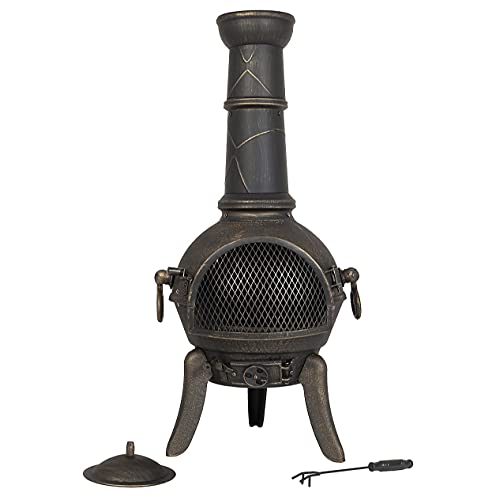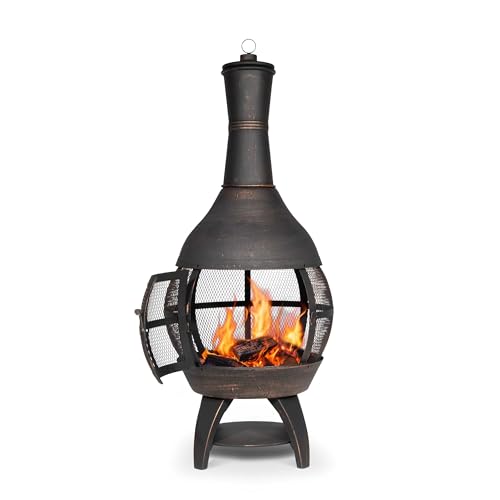Fire Pits & Chimineas Techniques To Simplify Your Everyday Lifethe Onl…
페이지 정보
작성자 Alphonso 작성일24-11-18 16:19 조회16회 댓글0건관련링크
본문
 chimineas and fire pits Vs Fire Pits
chimineas and fire pits Vs Fire PitsLike a stove with a potbelly, chimineas have an opening in the front to allow for stacking fuel and an attached chimney that draws smoke into. They are available in a variety of materials including clay and terra cotta for an authentic look, or iron and cast iron for more durability.
Metal models are more durable and can withstand higher temperatures. Clay models require additional attention. Both offer added warmth and ambiance to outdoor spaces.
Chimineas
Chimineas resemble fireplaces in many ways, however they provide an attractive appearance and are designed specifically for outdoor use. They are constructed from clay or terracotta, and can be decorated with bright themes inspired by Mexico. Modern chimineas tend to be made of materials such as cast iron and aluminium, which are more resistant to breaking and damage than traditional clay.
The chiminea, originally a fire in a potbelly was invented in Mexico and the Western states. They are mostly used to entertain however they can also be a focal piece in any outdoor space. A chiminea's long chimney can be used to direct smoke upwards, which helps to keep it from people who are sitting around it, as opposed to fire pits that often have an open flame that could cause sparks and embers to spread across the ground and surrounding areas.
Chimineas as well as fire pits provide warmth to outdoor spaces, however they offer distinct advantages and requirements for maintenance. Personal aesthetic preferences play an important part in this choice, since the intricate design of a chiminea can be a perfect match for different styles of gardens. A fire pit's minimalist, sleek design is suitable for many outdoor spaces.
The difference in maintenance for fire pits and chimineas is also largely due to the materials used. Terra cotta, clay and cast iron are more prone to damage. Therefore, Chimineas usually require more frequent maintenance than fire pits & chimineas (just click the following website) pits.
Both kinds of outdoor fire features are popular for creating a cozy, inviting and welcoming place to get together with family and friends for drinks or dinners. The closed and enclosed design of a chiminea log burner makes it more suitable for smaller gatherings and can be more effective in warming up the space. Chiminesas' safety advantages come from the fact that embers and sparks that fly off the fire are more contained. Fire pits must be placed carefully to minimize the risk of fire and should be monitored.
Fire pits
When designing an outdoor space, you might be confronted with the decision to include a fire pit or chiminea. Both provide warmth and elegance to your patio or garden but they differ in terms of their design operations, features, and safety features. We'll help you find the best option for your space by reviewing the initial costs, maintenance cost, fuel costs and much more. We'll examine the heat output smoke, the safety and heat output of both.
A chiminea, also known as chimenea (pronounced Che-meh-NEH-yah) is an open-air fireplace that comes with an chimney and can be used to cook food. They can be constructed from clay, metals like steel or cast iron, or cement or stone. They come in many shapes sizes, styles, and sizes to suit various outdoor decors. Depending on the material they are made from they can be insulated for added comfort and a smaller flame, which reduces the risk of stray sparks and helps ensure safety during operation.
Although chimineas can be used with wood and charcoal but it is best to use seasoned logs or kiln-dried logs. Moisture wood produces more smoke and heats less efficiently. Chimineas require a larger fire to keep warm, which can result in more smoke. This can be reduced by using a log grates, ensuring proper airflow, and ensuring the chiminea.
Fire pits can be constructed from a range of materials, with steel being the most sought-after due to its strength and affordable. Some are portable, while others are designed to be permanent fixtures within the space. They are typically built into the ground or on a deck that is raised and are available in a variety of sizes, shapes and finishes that match a range of outdoor decors. Gas is a viable option since it offers convenience and control. Charcoal and wood can also be used.
Fire pits can be more difficult to maintain than chimineas, but generally, they are regarded as more dangerous. Their open design allows for more sparks to fly around, which can pose a risk to children and pets. To avoid accidents, they must be kept away from flammable objects and kept under constant surveillance. They can also produce a lot of smoke and ash which could make them uncomfortable for some people to be near.
Safety
Chimineas, as well as fire pits can add warmth and awe to an outdoor area. However the use of them is not without dangers. Both are extremely hot, and caution should always be taken when using them, particularly when working with animals and children. Both are suitable for surfaces that are susceptible to cracking in extreme heat (see below) which is why putting the sand layer inside your chiminea, or a stone slab and brick underneath the fire pit is recommended. Both can release lots of smoke, which could be an issue for those who live in areas that are windy. The chiminea is less susceptible to the wind blowing embers and ash around because the fire is contained within. The opening is only one-sided and you cannot see the back, so it's easy to leave the chiminea alone when the wind is strong.
It is crucial to use only seasoned dry and kiln-dried logs for both types of fireplace since they burn more efficiently and produce less smoke. Avoid flammable materials such as newspaper, twigs and garbage which could quickly ignite and cause a dangerous reaction.
Be aware of any local burning restrictions. They may result from adverse conditions, which can result in the high levels of emissions, and can raise levels of fine particle pollution to unhealthy levels. These harmful toxins can cause respiratory problems if inhaled.
Make sure you have a bucket of water or a garden hose in case the fire gets out of control. Also, make sure that the area around the fire pit is free of branches, twigs and leaves that are prone to catch fire. It's also recommended to keep a small first aid kit near the fire pit in case someone is injured by sparks and smoke. If properly maintained, both a chiminea and fire pit can last for an extended time. However, terracotta and clay are more fragile than metal and can break under extreme temperatures so a cast-iron chiminea or fire pit is a better option for a durable and long-lasting addition to your patio.
Maintenance
If you do not maintain your chiminea, or fire pit, in your backyard, it can cause serious dangers. If used improperly or situated too close to a building, shrubbery or other structures, it can lead to a house fire and cause severe injuries or damages. It is essential to ensure that only natural materials like wood can be burnt and that no garbage, plastics or liquid fuels should be utilized. You should also look up your local weather forecasts to comply with rules governing when you are allowed to burn. In the end, it's a good idea to keep a fire hose or extinguisher within reach in case of emergencies.
A chiminea, a traditional outdoor wood-burning fireplace, provides warmth and atmosphere in gardens and patios. Made of clay, iron or cast iron, chimineas are available in a variety of designs and finishes. Many chimineas have an intricate, traditional design that imparts a rustic look to outdoor areas. chimineas sale are also considered to be more sustainable than fire pits as they produce less smoke and particulate matter emissions.
Cleaning your chiminea on a regular basis will keep it in top condition. Begin by removing any unburnt wood or ash from the inside of the grate. Next, make small flames using tiny pieces of wood that can be used as a kindling. After about an hour then carefully dowse it with water until it completely smothers the flames. Wait for the temperature of the chiminea to decrease before lighting a new fire.
Chimineas can be a gorgeous addition to your outdoor space, but they require more upkeep than fire pits. They require frequent cleaning to avoid corrosion and other types of damage caused by the elements. Chimineas are also quite fragile and can break or crack if not handled with care.
 In the end, the decision to choose a fire pit or chiminea is based on personal preference and budget considerations. Both options offer advantages however, you should consider the initial cost and long-term costs before choosing which is best for your home. If you're seeking a long-lasting option, think about a custom-built chiminea or a fire pit that is made of durable materials such as stone or steel and can withstand greater use and harsh weather conditions.
In the end, the decision to choose a fire pit or chiminea is based on personal preference and budget considerations. Both options offer advantages however, you should consider the initial cost and long-term costs before choosing which is best for your home. If you're seeking a long-lasting option, think about a custom-built chiminea or a fire pit that is made of durable materials such as stone or steel and can withstand greater use and harsh weather conditions.댓글목록
등록된 댓글이 없습니다.


